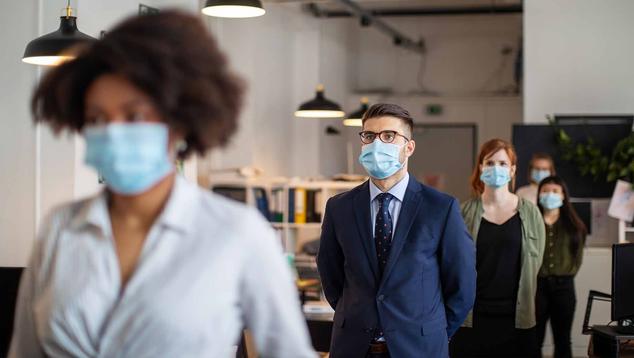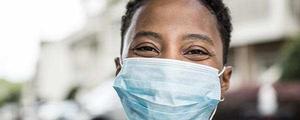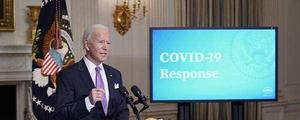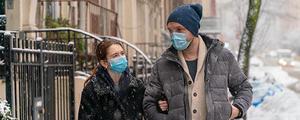Story Highlights
- 47% of U.S. adults "completely" or "mostly" isolating themselves
- Isolation remains above last fall's 38%, but well below spring's levels
- Avoidance of most public places still above pre-holiday levels
WASHINGTON, D.C. -- At a time when U.S. coronavirus infections have decreased sharply from their peak and the public perceives the COVID-19 situation as improving, there has been relatively little change in Americans' practice of strict social distancing. Currently, 47% of U.S. adults say they are "completely" or "mostly" isolating themselves from people outside their household, compared with 50% in November and December when cases were surging. Just prior to that surge, a record low of 38% reported they were completely or mostly isolating themselves.

Line graph. The percentage of Americans completely or mostly isolating themselves from having contact with people outside their household. Forty-seven percent currently say they are isolating themselves, compared with 50% in November and December. In October, a low of 38% were isolating themselves. In late March and April roughly seven in 10 Americans were isolating themselves, which dropped into the 40s by June.
During the initial stages of the pandemic, when most states imposed lockdowns for nonessential services, as many as 75% of Americans indicated they were practicing strict social distancing. As states began to loosen restrictions in May and June, the percentage of people isolating themselves fell below the majority level, dropping to 40% in late June. Then, as the second surge of cases hit the U.S. in the summer months, social distancing ticked up -- reaching 49% -- in late July/early August, before dropping again into the fall months as cases once again declined.
Gallup has tracked Americans' COVID-19-related behavior and attitudes since March 2020, after the Trump administration's March 13 declaration of a national emergency. The latest results are based on Feb. 14-21 interviews with more than 3,000 members of Gallup's probability-based U.S. panel.
Previously, Gallup found that Democrats, women, college graduates and nonworking Americans were among the subgroups most likely to be completely or mostly isolating themselves from people outside their household, and those patterns still hold today.
Coronavirus-Avoidance Measures Still Common
Majorities of U.S. adults are taking each of several actions to avoid contracting the coronavirus, including 70% who are avoiding large crowds, 56% who are avoiding public places and 54% who are avoiding small gatherings.
Consistent with the trend in isolating themselves from others outside their household, Americans' avoidance of these specific activities was greatest in late March/early April, including highs of 91% avoiding large crowds, 84% avoiding small gatherings and 79% avoiding public places.
In early fall, avoidance of these activities dipped to their lowest points -- but with the surge in cases in November, increasing percentages of Americans again said they were avoiding public places and small gatherings with friends and family. While 2021 has seen slightly fewer U.S. adults saying they are avoiding public places and small gatherings, the percentages doing so remain above the late October/early November levels.
Avoidance of large crowds appeared to be less affected by the November/December increase in cases, as the percentage who said they were doing so held steady through late fall. It has come down in early 2021 to 70%, the lowest Gallup has measured since 59% in March 2020, before many states instituted stay-at-home orders.

Line graph. The percentage of Americans avoiding public places is 70%, down from 91% in late March and early April. The percentage has not varied much since July. The percentage avoiding public places, 56%, is down from 61% in November but still higher than the 53% who were doing so in October. Likewise, the 54% avoiding small gatherings is higher than the 50% in October. But roughly eight in 10 were avoiding public places and small gatherings in late March and early April.
Additionally, 66% of Americans now say they are avoiding travel by airplane, bus, subway or train. That too is down from the peak of 91% in early April. The current figure is just above the trend's low point of 63% in September.
Gallup first asked Americans in early April if they were wearing face masks when out in public. At that time, 51% said they were doing so and another 31% were considering it. By the end of April, 77% reported wearing face masks in public. That figure rose to 90% in July and has been at about that level since, including 89% in the current survey.

Line graph. Early in the pandemic, in early April, only 51% of Americans said they wore a face mask when outside the home. The percentage has increased since then, registering at 89% of Americans today. It has remained at around nine in 10 Americans since July 2020.
Texas and Mississippi recently lifted their mask mandates, joining 14 other states without such directives -- so it is possible that face mask usage will decline if an increasing number of states no longer require people to wear face coverings when in public.
Restaurant Visits Ticking Back Up
Restaurants have been some of the hardest-hit businesses during the pandemic, and restrictions on restaurant dining have been among the most controversial public health measures. In late October/early November, before the late 2020 surge in coronavirus infections, 28% of U.S. adults reported having visited a restaurant -- and 18% having dined in at a restaurant -- within the past 24 hours. Both figures were the highest measured by Gallup since the pandemic began.
After declining in November and December, perhaps because of increased restrictions on restaurant dining in many states, restaurant visits are back up to 24%, and reports of dining in are up to 16%. But as on most other measures, the current figures are still not back to the levels they were in the fall.

Line graph. In March 2020, 12% of Americans said they had visited a restaurant in the past 24 hours. In February 2021, 24% said they have done so. In May 2020, only 8% of Americans said they had dined in at a restaurant in the past 24 hours. In February 2021, 16% said they had done so.
Visits to most other types of establishments are also below where they were in late October/early November. However, nearly all are well above the levels measured during the beginning stages of the pandemic.
For example, 20% say they have visited someone else's home or apartment within the past 24 hours, double the percentage from early April. However, in June, a high of 27% said they had visited someone else's home.
| Apr 5, 2020 | May 10, 2020 | Jun 21, 2020 | Aug 2, 2020 | Nov 1, 2020 | Nov 29, 2020 | Feb 21, 2021 | |||||||||||||||||||||||||||||||||||||||||||||||||||||||||||||||||||||||||||||||||||||||||||||
|---|---|---|---|---|---|---|---|---|---|---|---|---|---|---|---|---|---|---|---|---|---|---|---|---|---|---|---|---|---|---|---|---|---|---|---|---|---|---|---|---|---|---|---|---|---|---|---|---|---|---|---|---|---|---|---|---|---|---|---|---|---|---|---|---|---|---|---|---|---|---|---|---|---|---|---|---|---|---|---|---|---|---|---|---|---|---|---|---|---|---|---|---|---|---|---|---|---|---|---|
| % | % | % | % | % | % | % | |||||||||||||||||||||||||||||||||||||||||||||||||||||||||||||||||||||||||||||||||||||||||||||
| Grocery store | 40 | 47 | 54 | 50 | 53 | 50 | 51 | ||||||||||||||||||||||||||||||||||||||||||||||||||||||||||||||||||||||||||||||||||||||||||||
| Your place of work | 24 | 29 | 33 | 32 | 37 | 35 | 31 | ||||||||||||||||||||||||||||||||||||||||||||||||||||||||||||||||||||||||||||||||||||||||||||
| Restaurant | 10 | 13 | 26 | 25 | 28 | 22 | 24 | ||||||||||||||||||||||||||||||||||||||||||||||||||||||||||||||||||||||||||||||||||||||||||||
| Other store | 12 | 20 | 28 | 28 | 26 | 26 | 23 | ||||||||||||||||||||||||||||||||||||||||||||||||||||||||||||||||||||||||||||||||||||||||||||
| Someone else's home or apartment | 10 | 18 | 27 | 23 | 21 | 20 | 20 | ||||||||||||||||||||||||||||||||||||||||||||||||||||||||||||||||||||||||||||||||||||||||||||
| Pharmacy | 13 | 16 | 19 | 18 | 19 | 16 | 15 | ||||||||||||||||||||||||||||||||||||||||||||||||||||||||||||||||||||||||||||||||||||||||||||
| Doctor's office, hospital or treatment center | 5 | 8 | 16 | 13 | 14 | 10 | 12 | ||||||||||||||||||||||||||||||||||||||||||||||||||||||||||||||||||||||||||||||||||||||||||||
| Place of worship | n/a | n/a | 6 | 6 | 11 | 9 | 9 | ||||||||||||||||||||||||||||||||||||||||||||||||||||||||||||||||||||||||||||||||||||||||||||
| Salon or barbershop | n/a | n/a | 6 | 6 | 7 | 3 | 5 | ||||||||||||||||||||||||||||||||||||||||||||||||||||||||||||||||||||||||||||||||||||||||||||
| Gym | n/a | n/a | 3 | 3 | 6 | 3 | 5 | ||||||||||||||||||||||||||||||||||||||||||||||||||||||||||||||||||||||||||||||||||||||||||||
| Public transportation | <1 | 1 | 1 | 1 | 2 | 2 | 2 | ||||||||||||||||||||||||||||||||||||||||||||||||||||||||||||||||||||||||||||||||||||||||||||
| Travel | 1 | 2 | 4 | 2 | 2 | 3 | 2 | ||||||||||||||||||||||||||||||||||||||||||||||||||||||||||||||||||||||||||||||||||||||||||||
| Note: Items sorted based on % visiting in February 2021. Place of worship, gym, and salon or barbershop were added to the survey on May 25, 2020. | |||||||||||||||||||||||||||||||||||||||||||||||||||||||||||||||||||||||||||||||||||||||||||||||||||
| Gallup Panel | |||||||||||||||||||||||||||||||||||||||||||||||||||||||||||||||||||||||||||||||||||||||||||||||||||
Implications
When the pandemic began, 3% of Americans expected the disruption to the nation's social and economic activity to continue beyond 2020. A year later, close to half of U.S. adults still say they are completely or mostly isolating themselves from people outside their household, and majorities are avoiding public places, large crowds and small gatherings.
Some progress toward increased economic and social activity seen in the fall was quickly reversed when coronavirus cases surged around the holidays. Now that infections have come way down, and roughly one in five Americans have been partially or fully vaccinated, the conditions exist for more of society to reopen. However, health experts warn that a full return to pre-pandemic activity is not possible until the public has reached a level of herd immunity.
Even though cases are down from their January peak, they still remain at a high level in absolute terms -- higher than those registered in the first and second waves in the spring and summer.
As such, public health experts and policymakers are doing their best to navigate citizens through a precarious stage in the pandemic, when progress is being made but opening public places up too soon could erase some of that progress.
Learn more about how the Gallup Panel works.




